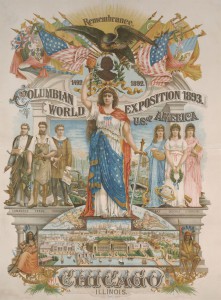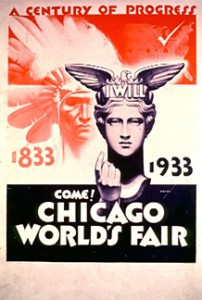The advertisements for the World’s Fairs of 1893 and 1933 both drew on classical imagery to convey the host city’s ambitions to display to the world its utterly modern, exquisitely progressive character.
In both cases, the classical female figure is combined with indications of the distinctive local architectural innovations.
The 1893 advertisement features a central classical figure atop a representation of the plan of the “White City” with its neoclassical buildings and extensive waterways. In the advertisement for the 1933 fair an Art Deco-style Mercury is rendered in skyscraper-steel.
Images of Indigenous Peoples were used in an apparent effort to to suggest the marriage of a distinctly American (non European) setting and high cultural achievement, that is “Progress.”


